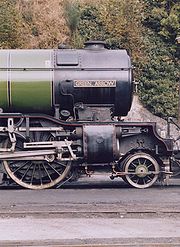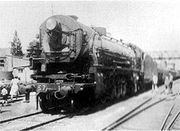
Gresley conjugated valve gear
Encyclopedia

Valve gear
The valve gear of a steam engine is the mechanism that operates the inlet and exhaust valves to admit steam into the cylinder and allow exhaust steam to escape, respectively, at the correct points in the cycle...
for steam locomotive
Steam locomotive
A steam locomotive is a railway locomotive that produces its power through a steam engine. These locomotives are fueled by burning some combustible material, usually coal, wood or oil, to produce steam in a boiler, which drives the steam engine...
s designed by Sir Nigel Gresley, chief mechanical engineer of the LNER, assisted by Harold Holcroft
Harold Holcroft
Harold Holcroft was a British railway and mechanical engineer who worked for the Great Western Railway , the South Eastern and Chatham Railway and the Southern Railway...
. It enables a three-cylinder locomotive to operate with only the two sets of valve gear for the outside cylinders, and derives the valve motion for the inside cylinder from them by means of levers (the "2 to 1 lever" and "equal lever"). The gear is sometimes known as the Gresley-Holcroft gear, acknowledging Holcroft's major contributions to its development.
Operation

If we approximate the motion of each valve by a sine wave — if we say the position of a valve in its back-and-forth travel is exactly proportional to the sine of the "driver angle", once we have set the zero point of driver angle at the position it needs to be for that valve — then the mathematics is simple. The position of the valve that is pinned to the long end of the 2-to-1 lever is
 , while the positions of the other two valves are supposed to be
, while the positions of the other two valves are supposed to be  and
and  . The position of the short end of the 2-to-1 lever is
. The position of the short end of the 2-to-1 lever is  -- which, it turns out, is midway between
-- which, it turns out, is midway between  and
and  for any value of
for any value of  . So a 1-to-1 lever pivoted on the short arm of the 2-to-1 lever will do the trick.
. So a 1-to-1 lever pivoted on the short arm of the 2-to-1 lever will do the trick.Crank angles
Locomotives with Gresley valve gear must have the three pistons operating at precisely 120 degree intervals. (Different spacings could be accommodated by different lever proportions, if there were any advantage to a spacing other than 120-120-120.) In order for the inside crank to clear the leading coupled axle, the inside cylinder of a locomotive with Gresley valve gear is typically positioned higher than the outside cylinders and angled downward. To maintain a smooth flow of torque, the crank angles are offset from equal 120 degree spacing to compensate for the angle of the inside cylinder (eg. 120/113/127 degrees). The resultant timing of the blast from steam exiting the cylinders still gives these three-cylinder locomotives a regular exhaust beat.Problems
The main difficulty with this valve gear was that at high speeds, inertial forces caused the long conjugating lever to bend or "whip". This had the effect of causing the middle cylinder to operate at a longer cutoffCutoff (steam engine)
In a steam engine, cutoff is the point in the piston stroke at which the inlet valve is closed. On a steam locomotive, the cutoff is controlled by the reverser....
than the outer cylinders, and therefore to produce a disproportionate share of the total power output, leading to increased wear of the middle big end. Sustained high speed running could sometimes cause the big end to wear rapidly enough that the increased travel afforded to the middle piston by the increased play in the bearing was enough to knock the ends off the middle cylinder. Although the problem could be contained in a peacetime environment with regular maintenance and inspections, it proved to be poorly suited to the rigours of heavy running and low maintenance levels of World War 2. This gave rise to big-end problems on the centre cylinder connecting rod on the famous A4 class of streamlined Pacifics and many of these locomotives were fitted with a reduced diameter piston and had the inside cylinder lined up as a temporary measure. Gresley's successor at the LNER, Edward Thompson
Edward Thompson (engineer)
Edward Thompson was Chief Mechanical Engineer of the London and North Eastern Railway between 1941 and 1946.- Biography :Edward Thompson was the son of an assistant master at Marlborough College. He was educated at Marlborough before taking the Mechanical Science Tripos at Pembroke College,...
, was critical of this particular valve gear
Valve gear
The valve gear of a steam engine is the mechanism that operates the inlet and exhaust valves to admit steam into the cylinder and allow exhaust steam to escape, respectively, at the correct points in the cycle...
. As well as introducing new two-cylinder designs, he set about rebuilding Gresley locomotives with separate sets of Walschaerts valve gear for each cylinder.
USA and Australia

American Locomotive Company
The American Locomotive Company, often shortened to ALCO or Alco , was a builder of railroad locomotives in the United States.-Early history:...
under license and the 4-12-2
4-12-2
Under the Whyte notation for the classification of steam locomotives, 4-12-2 represents the wheel arrangement of four leading wheels, twelve coupled driving wheels, and two trailing wheels.Other equivalent classifications are:...
locomotives they built for the Union Pacific Railroad
Union Pacific Railroad
The Union Pacific Railroad , headquartered in Omaha, Nebraska, is the largest railroad network in the United States. James R. Young is president, CEO and Chairman....
between 1926 and 1930 were the largest locomotives to use this valve gear. It was also used in Australia for the Victorian Railways
Victorian Railways
The Victorian Railways operated railways in the Australian state of Victoria from 1859 to 1983. The first railways in Victoria were private companies, but when these companies failed or defaulted, the Victorian Railways was established to take over their operations...
S class
Victorian Railways S class
The S class was an express passenger steam locomotive that ran on Victorian Railways from 1928 to 1954. Built when the VR was at its zenith and assigned to haul premier interstate express passenger services, the S class remained the VR's most prestigious locomotive class until the advent of diesel...
4-6-2
4-6-2
4-6-2, in the Whyte notation for the classification of steam locomotives, represents the wheel arrangement of four leading wheels on two axles , six powered and coupled driving wheels on three axles, and two trailing wheels on one axle .These locomotives are also known as Pacifics...
of 1928 and New South Wales Government Railways
New South Wales Government Railways
The New South Wales Government Railways was the government department that operated the New South Wales Government's railways until the establishment of the Public Transport Commission in 1972. Although later known officially as the Department of Railways, New South Wales, it was still generally...
D57 class 4-8-2
4-8-2
Under the Whyte notation for the classification of steam locomotives, 4-8-2 represents the wheel arrangement of four leading wheels on two axles , eight powered and coupled driving wheels on four axles, and two trailing wheels on one axle...
of 1929.
As in the UK, the mechanism was not without its problems. Some of the Union Pacific 9000 class locomotives were converted to a "double Walschaerts" valve gear, while later examples were built with roller bearings for the moving parts of the Gresley mechanism. In Australia, later VR and NSWGR 3 cylinder locomotive designs used alternative mechanisms to the Gresley system in an effort to overcome its high maintenance overhead. The Victorian Railways H class
Victorian Railways H class
The H class was an express passenger steam locomotive that ran on Victorian Railways from 1941 to 1958. Intended to eliminate the use of double heading A2 class locomotives on Overland services on the steeply graded Western line to Adelaide, wartime restrictions led to only one locomotive being built...
of 1941 was fitted with a German Henschel und Sohn
Henschel & Son
Henschel & Son was a German company, situated in Kassel, best known during the 20th century as a maker of transportation equipment, including locomotives, trucks, buses and trolleybuses, and armoured fighting vehicles and weapons....
conjugated valve gear mechanism which was judged to be superior to the Gresley system, while in New South Wales the D58 class
New South Wales D58 class locomotive
The D58 class was a class of steam locomotives operated by the New South Wales Government Railways in Australia. They were built with the 4-8-2 wheel arrangement.- Construction :...
of 1950 utilised a rack and pinion
Rack and pinion
A rack and pinion is a type of linear actuator that comprises a pair of gears which convert rotational motion into linear motion. A circular gear called "the pinion" engages teeth on a linear "gear" bar called "the rack"; rotational motion applied to the pinion causes the rack to move, thereby...
system which while in theory an improvement over the Gresley system, proved in practice to be even more problematic.
External links
- Southern California Chapter of the Railway and Locomotive Historical Society Information on Union Pacific ALCO-built three cylinder 4-12-2 UP9000, including sound recordings and photographs

